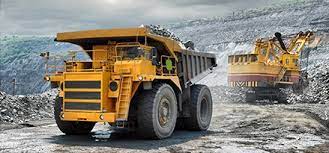Mining sector is one of the most crucial sectors for any country. It helps boost the economy of the state as minerals obtained by mining have high demand across the globe. Thus, machinery used in mining needs to be in good health to carry out mining operations efficiently. Thus, the choice of the right industrial lubricants ensures that the machines work fine.
For safe mining experience, it is imperative to use energy-efficient industrial lubricants to reduce the amount of waste produced. They help reduce the thermal stress on equipment with extended lifetimes. Right lubricants help reduce machine’s downtime. To avoid machine failures timely changing lubricants can help you detect the problems in their early stages.
As mining operations are on the rise, so is the need for the high quality lubricants for efficient working of machines under abrasive conditions with exceptional temperature. Timely industrial lubrication can avoid cost overruns. When you spend less on machine maintenance and failures, you can use that cost to improve your mining operations. This also helps in preventing loss of productivity.
There are many parts in which lubricants can be used in modern day mining equipment, with the most common being gears, compressors, engines, hydraulic boom arms, drive trains, transmission fluids, and coolants. Lubricants can also be used in both fixed and mobile mining equipment. The latest lubricant systems used in mining consist of many parts viz.a grease pump, a motor used to drive the grease pump, and either an injector or a valve to control the release of lubricant into different areas of the machinery.
As per market reports, there is a shift from short-term lubricants to long-life lubricant systems. It is starting to show many benefits for mining companies as well like increase in productivity, reduction in maintenance, improved safety and lower long-term cost. Many long-term lubricants are designed to be more energy efficient which further reduces the impact on the environment.
As per market research company, Future Market Insights, for mining companies, operational and maintenance costs account for a significant share. Increasing awareness among companies about the proper usage of lubricants has decreased the maintenance cost of equipment. Moreover, it has also helped companies to avoid unexpected shutdowns.
Furthermore, technological advancements in lubricants is acting as a catalyst for mining lubricants market players to move up the value chain. As per reports, the mining lubricants marketplace remains moderately fragmented, with Shell, Exxonn Mobil and Chevron as the market leaders. With size of mining equipment undergoing a huge shift, manufacturers are strategising to come out with differentiated offerings that lower maintenance costs.
The global mining lubricants market size was valued at USD 2.06 billion in 2016.FMI’s suggests that mining lubricants market s slated for 3.4% growth through the forecast period (2022-2030). In yet another report the mining lubricants market is slated to reach US$ 2.98 Bn by 2030. Growing investments in Asia Pacific are likely to offset subdued growth in key markets, with coal and iron ore mining sector driving demand.
Furthermore, the reports opine that High performing lubricants and greases are growing in demand as covid-19 tightens operating costs. Coal mining largest application avenue, accounting for over 50% mining lubricants market share. Open pit mining is heightening the adoption of loaders, roof bolters, draglines and haul trucks thus boosting demand for lubricants. Bio-based lubricants is marked as a long-term solution, but current market dynamics are in favour of synthetic variants.
It should be noted that the manufacturers are working on product differentiation strategies to develop lubricants that have prolific anti-friction properties, high pressure additives and the correct anti-wear agents. Sharper profit margins are expected by lubricants used in equipment such as coal crawler excavators.
Growth of drilling and exploration activities on a global level, as well as increased demand for mining equipment, has a direct and positive impact on the industry demand. Moreover, equipment manufacturers increasing their capital spending to provide for the new sites opening up is expected to accelerate the growth of the market over the forecast period. As per Grand View Research high growth in mining equipment such as continuous miner, haul truck, scaler, hydraulic shovel, motor grader, and dragline excavator in existing and unexploited plants is expected to complement the global industry growth.
The report further says that the stringent regulations imposed by government bodies towards environmental protection are anticipated to augment the demand for bio-based lubricants. As a result, regulatory support towards bio-based products coupled with superior mechanical properties of bio-lubricants as compared to synthetic lubricants is expected to act as an advantage for the product market in the near future.
The global lubricants market is governed by stringent regulations ,says the report, from various environmental agencies at the regional level. Since lubricants are produced through mineral oils and petrochemicals, they have an impact on the environment in terms of biodegradability, aqueous toxicity, and recyclability. But, there is a rise in the opportunities for implementing new technology, and the companies can benefit from this by carefully administrating their potential while making this technology available on the market.
The untapped or unexplored sites in Congo, Gabon and Zambia in Africa, and Peru, Brazil and Chile in Latin America, and the growing demand for mining products including drills & breakers, crushing, pulverizing & screening equipment, and mineral processing machinery coupled with mineral processing machinery market is expected to fuel the demand for the product as a result of rising excavation of minerals and metals, says the report.
High industrialization and consumerism, increasing population as well as disposable income and rapid urbanisation are expected to fuel the demand for automatic lubrication systems in developing countries including India and China due to the rise in demand from mining and metal industries such as zinc, copper, iron ore and bauxite.
Report mentioned mineral oil lubricants as the most extensively used that accounted for 83.8% of the global volume share in 2016. It is obtained from the distillation of crude, which is quick to dispose of and reuse on account of existing infrastructure in place. The rise in demand for mineral oil lubricants is due to its compatibility with metals, seals, and coatings, which can be further manipulated chemically to produce semi-synthetic through the distillation process.
As mineral oil lubricants are cheaper than synthetic and bio-based lubricants and provide an enhanced operational benefit through supplying a stable structure to equipment, they are expected to exhibit substantial growth over the forecast period. The high growth of mineral-based lubricants is expected over the next eight years, says the market report, on account of their hydrophilic properties and solvency, as well as their ability to work at standard temperatures without advanced machinery.
The year 2015 saw the rise of these lubricants in coal mining at 217.9 kilo tons in 2015 and is expected to witness growth due to its increasing penetration in construction and commercial industries.
Coal can be segmented into four parts including lignite, sub-bituminous coal, bituminous coal, and anthracite. It has various applications such as thermal power generation, steel manufacturing, cement manufacturing, and heating. High Demand for coal in the production of a variety of metals, chemicals, ceramics, and papers by manufacturing plants is anticipated to increase mining activities, thereby spurring the demand for the product in coal mining.
The product is also used in heavy load equipment during the process of coal mining, wherein coal mines require high-performance lubricants having resistance to oxidation, high viscosity index as well as corrosion prevention properties, therefore augmenting the demand for mining lubricants in the related industry.
Moreover, increased demand for steel for the purpose of urbanization and industrialization in developing nations mainly India and China, as well as dependence on steel for construction and transportation purposes, is expected to augment the demand for iron ore mining, which will in turn fuel the demand for the product in the iron ore extraction sites.
Asia Pacific is expected to show high volume gains at a CAGR of 5.3% from 2016 to 2025. Mining is a significant economic activity for Asian countries including India, China, Australia, Indonesia. The Asia Pacific is anticipated to grow at a significant rate owing to rapid industrialization and changing lifestyles. The growing automobile industry and consumer preference for white metal jewelry in the region is expected to fuel demand for the product over the forecast period.
FMI reports mention that oils segment has been estimated to account for about 96% of the overall sales of mining lubricants in the global market in terms of volume. The significant availability of the product across all regions has boosted its ease of application. Easy applicability of oils for mining activities as compare to grease has also bolster the growth rate of the segment.
Syntheic oils segment is estimated to create a valuation of US$ 2,762.2 Mn by the end of 2030 in the global business of mining lubricants. Significant growth in the use of synthetic oils over bio-based lubricants will create rising demand for mining lubricants till forecast period.
The coal mining sector is projected to register steady growth owing to demand in coal in emerging countries of Asia Pacific. Rapid growth in use of coal base process in industries and different end use products are the growth drivers of the mining lubricants market.
High rate of production of coal use for commercial, industrial and other purposes and substantial revenue generation in this sector has fuel the demand for mining lubricants. The global mining lubricants industry is estimated to be a consolidated market with key manufacturers having a key share of the overall market. Market leaders are investing in research and development for the production of new and innovative products, technology and solutions to cater the growing demand from the end use industries. There is also a focus on expansion strategies by establishing new manufacturing units, acquisition of other players and collaborating with other market participants to enhance their market footprint.
Iron and coal are the most widely extracted resources in Asia, wherein the most involved countries including Australia, India, and China are expected to propel the demand for the related market. Moreover, Iron is the most widely used refractory metals, its demand in developing nations like India and China is fueling the demand for iron ore mining, which in turn is expected to augment the demand for mining lubricants in Asia Pacific.
Globally, North America is not only one of the major manufacturers of coal, iron, natural gas, and petroleum, but is also home to major North American manufacturers in the concerned industry such as ExxonMobil Corp., Bel-Ray Company Llc., and Quaker Chemical Corp. Therefore, the utmost reliability of these market players on coal and iron ore for industrial and commercial purposes is anticipated to augment the demand for mining lubricants over the forecast period.
The presence of various small and large scale manufacturers in the US, China and Germany has made the market highly competitive in nature. The market is dominated by various major participants including Royal Dutch Shell Plc., BP Plc., ExxonMobil Corp., Sinopec, Lukoil, Chevron Corp., and Total S.A.
Product differentiation along with the threat of forward integration by manufacturers to distribute mining lubricants and to capture market share is expected to result in high industry rivalry in the product’s market over the forecast period. The report states that the possible entry of new players is further expected to intensify rivalry in the industry.








